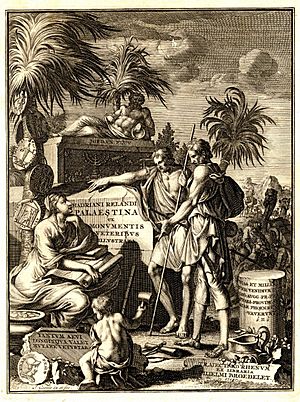Timeline of the name "Palestine" facts for kids
This article explores how the name "Palestine" has been used to describe a place in the Middle East throughout history. We'll look at different versions of the name, like "Filastin" and "Palaestina," and see when and where they appeared. It's like tracing the journey of a name through time!
Contents
Early Mentions of the Name
The very first known mention of a name similar to "Palestine" comes from ancient Egypt. Around 1150 BC, during the time of Ramesses III, Egyptian writings used the word "Peleset" (pronounced P-r-s-t). This word appeared in five different inscriptions, talking about a nearby group of people or a land. One of the earliest mentions is at the Medinet Habu temple, where it describes the Peleset as fighters against Egypt.
The Assyrian Connection
Later, the Assyrians, another powerful ancient empire, also used a similar name for this region. They called it "Palashtu" or "Pilistu." This started around 800 BC with Adad-nirari III and continued for over a century. It's important to know that neither the Egyptian nor the Assyrian writings gave clear borders for where "Peleset" or "Palashtu" exactly ended.
How Ancient Greeks and Romans Used the Name
The name "Palestine" as we know it today first appeared in the 5th century BC. This was when the famous ancient Greek historian Herodotus wrote about a "district of Syria, called Palaistinê." He described this area as being between Phoenicia and Egypt. Herodotus used the term for both the coastal areas and inland places like the Judaean Mountains and the Jordan Rift Valley.
Other Writers and Official Use
Many other Greek writers, like Aristotle and Pausanias, also used the word "Palaistinê." Roman writers, such as Ovid and Pliny the Elder, followed suit. Even Roman-Jewish writers like Josephus used it. However, the word wasn't found on any official coins or inscriptions from the Hellenistic period. It only started appearing in official use in the early 2nd century AD.
Palestine as a Roman Province
A big change happened in 135 AD. After the Romans put down the Bar Kokhba Revolt, they decided to rename a large area. They merged two Roman provinces, Roman Syria and Roman Judaea, into a new province called "Syria Palaestina." This name change happened around the same time that Jerusalem was rebuilt and renamed Aelia Capitolina.
Why the Name Change?
Some people believe this name change was done to weaken the connection of the Jewish people to their historic homeland. However, this idea is debated by historians. The exact date when the province's name was changed is also not perfectly clear.
Palestine in Later Empires
Around 390 AD, during the time of the Byzantine Empire, the large province of Syria Palaestina was divided into three smaller parts: Palaestina Prima, Palaestina Secunda, and Palaestina Salutaris.
From Byzantine to Modern Times
When the Muslims later conquered the region, they generally kept the place names that the Byzantine administration had been using. So, the name "Palestine" continued to be used in Arabic. In more recent times, the name "Palestine" became common in English.
In the 20th century, the British used the name "Mandatory Palestine" for a territory they controlled after the Ottoman Empire fell. This territory was set up by the League of Nations. More recently, starting in 2013, the term has been officially used for the "State of Palestine." Both of these used the name "Palestine" for a new state that included parts of the land historically known as Palestine.


